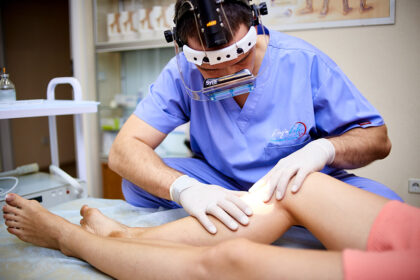An ankle brace is an essential tool for anyone recovering from an injury, managing chronic ankle instability, or looking to prevent future sprains. While choosing the right brace is important, how you fit it makes all the difference. A well-fitted ankle brace provides the ideal balance of support and comfort, helping you move freely while protecting your ankle from unnecessary strain.
In this guide, we’ll walk you through everything you need to know about properly fitting your ankle brace— from selecting the right size to testing it during activity. Whether you’re an athlete, a fitness enthusiast, or recovering from an ankle sprain, these steps will help ensure your brace works exactly as intended.
1. Start with the Correct Size
The first and most important step in getting the right fit is selecting the correct size. Every brand offers a sizing chart, typically based on your shoe size or the circumference of your ankle. Take a flexible measuring tape and measure around the narrowest part of your ankle, just above the ankle bones. Compare your measurement with the manufacturer’s sizing chart to find your match.
If you’re between sizes, it’s usually safer to size up. A brace that’s too small can cut off circulation or cause discomfort, while one that’s slightly larger can still be adjusted for a secure fit. Remember, sizing can vary between brands, so always double-check before purchasing.
2. Prepare Your Ankle Before Fitting
Before putting on your brace, make sure your ankle and foot are clean and dry. Moisture can cause the brace to slip or chafe, especially if it’s made of neoprene or elastic materials. If you prefer, wear a thin, breathable sock underneath — this can help absorb sweat and prevent skin irritation.
For rigid braces, it’s best to wear them directly on the skin to ensure maximum stability. For soft or compression-style braces, a thin sock is usually fine. Always check the manufacturer’s recommendations for best results.
3. Sit in the Right Position
When fitting your ankle brace, sit in a chair and place your foot flat on the floor with your knee bent at a 90-degree angle. This position keeps your ankle in a neutral, natural alignment — not pointed down or flexed upward. Proper positioning helps the brace mold comfortably to your foot and ensures that all straps or fasteners align correctly.
Avoid fitting your brace while standing on one foot or while your ankle is angled awkwardly. Doing so can cause uneven pressure or misalignment, leading to discomfort later on.
4. Adjust for Snug, Not Tight, Support
The goal of an ankle brace is to provide stability — not to restrict circulation. When putting it on, fasten each strap or lace so that the brace feels secure but not painfully tight. You should be able to move your toes freely and feel steady when standing or walking.
If your foot starts tingling, turning cold, or showing signs of swelling, the brace is too tight. Loosen it immediately and readjust. Conversely, if it feels loose or shifts as you move, tighten it slightly for better control.
The perfect fit should feel like a gentle, consistent hug around your ankle — supportive and steady, but still allowing comfortable motion.
5. Smooth Out Any Wrinkles or Folds
A common mistake when wearing an ankle brace is leaving wrinkles, folds, or bunching in the material. These small imperfections can lead to pressure points, friction, or even blisters during movement. After putting on your brace, run your fingers along the material to smooth it out, especially around the heel and sides of your foot.
If your brace has straps or laces, ensure they’re lying flat and not twisted. Even minor adjustments can make a big difference in comfort, particularly if you’re wearing the brace for extended periods.
6. Pair Your Brace with Proper Footwear
Your ankle brace and your footwear should work together — not against each other. Choose shoes with a wide enough opening to accommodate your brace comfortably. Athletic sneakers or supportive walking shoes are usually ideal, as they provide structure without constricting your foot.
Avoid shoes with narrow fits, high heels, or flimsy soles. They can compromise your balance and reduce the effectiveness of the brace. When trying on new shoes, wear your ankle brace to ensure the combination feels natural and stable.
For athletes, testing your brace with your sport-specific footwear (like soccer cleats or basketball shoes) ensures that it won’t interfere with performance.
7. Test the Fit During Movement
Once your ankle brace feels comfortable, it’s time to test how it performs in motion. Stand up, take a few steps, and gently move your ankle in different directions — up, down, and side-to-side. You should feel supported without experiencing pinching or excessive restriction.
If you notice the brace shifting, slipping, or creating pressure points, pause and make small adjustments. Sometimes, a slight tightening or repositioning can make a huge difference.
Athletes or active users can try light exercises such as heel raises, squats, or short jogs to ensure the brace performs well under movement. The key is finding a balance between support and natural motion.
8. Reassess the Fit Over Time
Your ankle may change during recovery — swelling may reduce, or your mobility may improve. Because of this, it’s important to reassess your fit every few days, especially in the first few weeks of wearing your brace. If it starts to feel loose, make minor adjustments or re-tighten the straps.
Similarly, if your brace begins to feel tighter than usual, check for swelling or irritation. You may need to loosen it temporarily or consult your healthcare provider if the discomfort persists.
Remember: a properly fitted brace should feel secure and comfortable throughout your daily activities.
9. Care and Maintenance
Proper care helps maintain your brace’s fit and lifespan. Wash it regularly according to the manufacturer’s instructions — usually with mild soap and air drying. Avoid using heat or dryers, as high temperatures can damage elastic materials or Velcro.
Inspect your brace regularly for signs of wear, such as stretched fabric, weakened straps, or fraying edges. A worn-out brace won’t provide the same support and may need replacement.
Keeping it clean and in good shape ensures consistent comfort and function.
10. When to Consult a Professional
If you’re unsure about your brace’s fit or still experiencing pain or instability despite wearing it, seek advice from a physiotherapist or orthopedic specialist. They can assess your ankle, recommend the most suitable type of brace, and help ensure it’s fitted correctly.
In some cases, custom-fitted braces may be recommended for complex injuries or long-term support needs.
Quality and Design Matter
Not all ankle braces are created equal. High-quality braces are anatomically designed to contour naturally to your foot and ankle, offering both comfort and precision support. Brands like Sporlastic focus on innovation and medical-grade materials to enhance stability while maintaining freedom of movement.
When you invest in a reliable brace, you’re not just buying protection — you’re investing in your recovery, comfort, and confidence.
Final Thoughts
A properly fitted ankle brace is your best ally in recovery, stability, and performance. Whether you’re healing from an injury or looking to prevent one, the right fit ensures comfort, protection, and peace of mind.
Take the time to measure accurately, fit carefully, and test thoroughly. A little attention to detail goes a long way toward making your brace feel like a natural extension of your movement — not a limitation.
Your ankles carry you through every step of life; give them the support and care they deserve.




